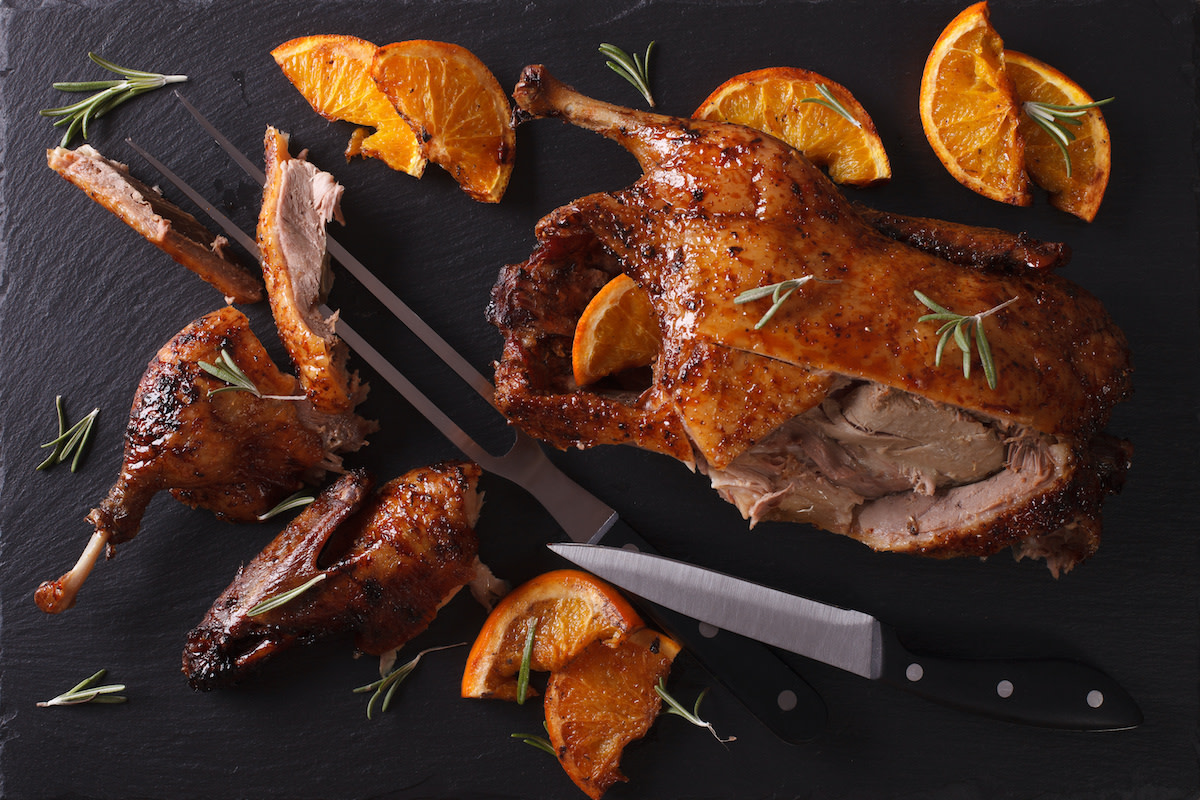How to Cook and Carve a Whole Roast Duck
Written by MasterClass
Last updated: Nov 15, 2021 • 3 min read
If you’re bored of chicken, consider duck. Roasting and carving the famously festive waterfowl may seem like the ultimate home cooking challenge for the uninitiated, but following this tutorial will show you exactly how to carve a duck at home.
Learn From the Best
4 Ways to Cook Duck
When prepared correctly, cooked duck meat is rich, tender, and flavorful—particularly compared to the far leaner turkey or chicken. Unlike other poultry, duck skin is especially fatty. This is handy both because the meat absorbs the fat’s flavor as it cooks and because the duck fat can be used to cook either the duck meat itself or your side dishes (roast potatoes are a common favorite). Note that duck breast meat is best medium rare: Rare duck tends to be chewy, while duck prepared well-done can take on a livery taste.
- 1. Braised: Braised duck, in anything from red wine to an aromatic stock, will infuse the meat with even more flavor and fall-off-the-bone texture. Throw it in the fridge to cool, and crisp it up in the oven once the skin has set.
- 2. Confit: One of the more well-known techniques involving the naturally fatty duck is confit, which requires cooking and preserving the meat in its own fat. Chefs often use this technique for duck legs.
- 3. Pan-roasted: Air-drying duck for three days in the refrigerator removes moisture from the skin so that it can crisp more readily during cooking. Prior to pan-roasting, temper the duck, letting it come to room temperature, and pierce the skin, which will allow the fat to render faster. As the duck fat renders, you’re left with a delicious crispy skin. The crispy duck meat can be served in an umami-packed salad or served with a sweet glaze for a holiday meal-worthy main course.
- 4. Roasted: Roasting duck in a 425 degrees Fahrenheit oven couldn’t be easier: Season the whole duck as you would a roast chicken and carefully flip halfway through, about two hours total. (Dousing it with boiling water before seasoning will help to tighten the skin.)
How to Carve a Duck
Once you’ve made your whole roast duck recipe of choice, use this step-by-step guide to break down the bird into delicious, servable portions.
- 1. Gather your materials. Remove your whole duck from the roasting pan and place it on a cutting board, breast side up. Reserve the pan drippings for another use. You’ll need a carving fork to hold the bird in place, as well as a sharp knife,—like a quality chef’s knife or cleaver—as you’ll be cutting through bone.
- 2. Separate the legs from the main body. Slice along where the thighs meet the main torso until you hit bone. Next, pressing the joint up from the underside of the bird, slice through the joint and the remaining meat and skin to completely sever the leg. (Be careful not to put your fingers in the path of your knife as you do this.) Repeat with the second leg.
- 3. Separate the drumsticks from the thighs. Working with one leg at a time, place the leg on the cutting board with the drumstick facing up. Slice through where the drumstick meets the thigh until you hit the leg joint. Then, following a process similar to what you did to separate the legs from the body, press up from below to expose the joint and slice through until you’ve separated the drumstick from the thigh. (Again, watch your fingers here.) Repeat for the other thigh and drumstick.
- 4. Prepare the breasts. Returning to the breast, position yourself so that the body cavity faces you. Starting at the neck side of the bird, slice into the middle to bisect the two breasts until you hit bone, then draw the knife toward you to create two equal portions of meat.
- 5. Separate the breasts. Tackling one side at a time, follow the contour of the rib cage with your knife to separate each breast from the carcass. These cuts will be perpendicular to the cuts you made when bisecting the breast, to allow you to fully separate the breast meat from the bird.
- 6. Remove the drummettes. Finally, stand up the duck with the cavity facing up and carefully slice through the joints connecting the wings to the main body. You’ve now fully disassembled your duck and are ready to slice and serve as you desire.
Mise En Place
To perfect the mother sauces and make French cuisine at home, you must master essential cooking techniques. Discover Chef Thomas Keller’s approach to setting up a home kitchen and sourcing quality ingredients like fish and clams when you sign up for the MasterClass Annual Membership.
